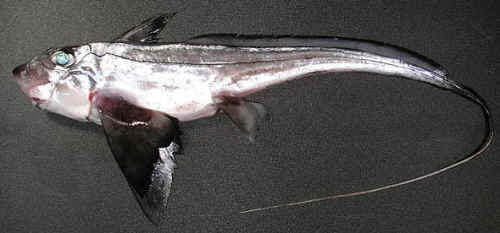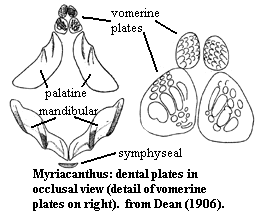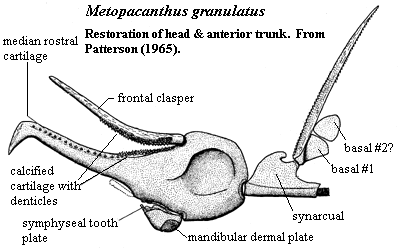
| Palaeos: |  |
Chondrichthyes |
| The Vertebrates | Chimaeriformes |
| Page Back | Unit Home | Unit Dendrogram | Unit References | Taxon Index | Page Next |
| Unit Back | Unit Next | Vertebrates Home | Vertebrate Dendrograms | Vertebrate References | Glossary |
|
Abbreviated Dendrogram
Thelodonti |--Placodermi | Eugnathostomata |--Chondrichthyes | |--Eugeneodontida | `--Chondrichthyes (Crown) | |--+--Cladoselachida | | `--Symmoriida | | |--Symmoriidae | | `--Holocephali | | |--Cochliodontidae | | `--+--Menaspidae | | `--Chimaeriformes | | |--Myriacanthoidei | | `--Chimaeroidei | |--Iniopterygii | `--Elasmobranchii | |--Xenacanthida | `--Ctenacanthiformes | |--Ctenacanthidae | `--Euselachii | |--Hybodontiformes | `--+--Synechodontiformes | `--Neoselachii Teleostomi |
Contents
Overview |

"Its ground tone is silver, but at every movement it reflects metallic hues -- brass, copper, and gold. Its snout is translucent, its optic cup is luminous, refracting pale greenish-blue, its iris brassy, and on head and trunk are tinges of rose, cobalt, pale-green and madder. ... Its back region is dark umber, through which pass, as the fish changes position, shades of olive and rose-madder. Its ventral region and fin bases are white, the fins themselves translucent and even transparent. In the adult, the paired fins show little pigment; they stand out from the body prominently, their anterior rims white, and their constant movement adds greatly to the fish's beauty. It may be added that the dorsal spine shows brightly in the water, forming a conspicuous anterior rime to the dorsal fin, whose remaining margin, in reality of a dark umber, now appears jet-black."
Dean (1906: 12-13), describing Chimaera colliei.
Image: Chimaera phantasma from Catalogue of Fishes of Kochi Prefecture.
Chimaeriformes: probably Myriacanthus + Chimaera
Range: from the Early Devonian. (?!)
Phylogeny: Holocephali:: Menaspidae + *: Myriacanthoidei + Chimaeroidei.
Characters: Maximum length about 1.5 m; mouth inferior; palatoquadrate fused to neurocranium; cephalic dermal armor common [P65] [1]; frontal clasper in males [DD93]; some may have paired mandibular and cephalic spines as Menaspidae [L80]; dentition of a few large permanent grinding tooth plates, at least 2 upper and 1 lower pair [DD93]; no more than 3 upper plates [P65]; tritoral pads primitively absent [P65]; jaw very short [L80]; notochord free or with polyspondylous calcified rings [DD93] [P65]; two dorsal fins, the first erectile, with short base, and preceded by an erectile spine, the second nonerectile, low, and with a long base; pectoral fins dibasal [P65]; pelvic fin with single basal [P65]; pelvis with both mixypterygial clasper and pre-pubic tenaculum [DD93] [P65, tenaculum only in "advanced forms"]; squamation primitively complete [P65]; sensory canals with open grooves lined by crescentic scales [DD93] [P65]; internal fertilization; eggs encased in a brown horny capsule; water for breathing is chiefly taken in through the nostrils.
Notes: Patterson's (1965) Chimaeriformes includes the Myriacanthus + Chimaera clade, but also the menaspids and Squaloraja, a species not treated in Palaeos at the present time. Note also that Patterson still held in 1965 that chimaeriforms had a placoderm connection. He was to abandon that view a few years later, for which defection he was intemperately criticized by Bendix-Almgreen (1971).
Links: Orders Summary (Fishbase); Chimaeriformes; Fauna Iberica/Iberian Fauna: Ord. Chimaeriformes (Chordata, Chondrichthyes); Chimaeriformes; temp; COURTENAY MUSEUM:Animal Classification; The American Elasmobranch Society Hompage; CHIMAERA Bibliography (surprisingly useless); The American Elasmobranch Society Hompage; Dulvey, N. K., and J. D. Reynolds. 1997.; Clave de condrictios; Thunderlizard - Portfolio - Marine Illustrations; The Search for Ancient Sharks - Prehistoric Shark Gallery; InterNevod: ОТРЯД ХИМЕРООБРАЗНЫЕ (CHIMAERIFORMES) (Russian: very well done and, together with companion page on Holocephali, Best on the Web); Rhinochimaera pacifica (Chimaeriformes, Rhinochimaeridae)- the ... (new species); Kardong K (abstract of phylogenetic paper from Lund & Grogan); 3D Homepage (important page by chimeroid enthusiast and expert, Dominique [Didier] Dagit); MF.Nes&&Aver;;'96.Transl.html (translation of a Russian paper on some new middle Cretaceous species).
References: Duffin & Delsate (1993) [DD93]; Lund (1980) [L80]; Patterson (1965) [P65]. ATW030724.
 Myriacanthoidei:
probably Myriacanthus > Chimaera. Acanthorhina,
Chimaeropsis, Delphyodontos, Myriacanthus.
Myriacanthoidei:
probably Myriacanthus > Chimaera. Acanthorhina,
Chimaeropsis, Delphyodontos, Myriacanthus.
Range: Late Triassic (Rhaetian) to Late Jurassic (Tithonian) of Europe (a belt from Britain to Italy) [DD93]; but also Delphyodontos, Early Carboniferous of North America.
Phylogeny: Chimaeriformes: Chimaeroidei + *.
 Characters:
head not flattened [P65]; long snout [D06]; snout somewhat expanded distally
and bent at right angle [D06]; mouth ventroterminal [L80]; rostrum studded distally with plates and dermal
denticles [D06]; 1+ tuberculated dermal plates on head [P65]; various
dermal plates, some with sharp spinous processes, particularly a mandibular
spine [D06]; some may have extensive dermal armor [L80]; spine-like frontal clasper [D06];
frontal clasper in both sexes? [P65]; symphysial tooth plate present, small, but sharp and very deep,
extending well below jaw line [D06]; "descending laminae" indicating
shark-like dentition [D+94]; at least two (2-3) upper and 1 lower pairs of tooth
plates [DD93]; tooth plates with diffuse distribution of tritors, rather than
tritoral pads as in chimaeroids [DD93] [P65]; some myriacanthoid genera (Halanodon)
have more chimaeroid-like tritoral areas [DD93]; lower main plates with diagonal
ridges running posteriorly or posterolaterally from the mesial end and labial
margin [DD93]; vomerine plates have three rows of large tritors [D06]; may be an
even smaller third anterior vomerine pair [D06]; folded areas on palatine and
mandibular plates have many tritoral points [D06]; notochord with calcified
rings in notochordal sheath [P65]; usual synarcual present [P65]; dorsal fin located more
posterior than in Recent chimaeroids [D06]; anterior dorsal fin spine with
lateral faces tuberculated [P65] and/or striated [W06]; prepelvic tenaculum consisting of
enlarged scales without skeletal support [P65]; squamation placoid
& not reduced [P65]; sensory line crescentic scales fused into short
cylinders [P65].
Characters:
head not flattened [P65]; long snout [D06]; snout somewhat expanded distally
and bent at right angle [D06]; mouth ventroterminal [L80]; rostrum studded distally with plates and dermal
denticles [D06]; 1+ tuberculated dermal plates on head [P65]; various
dermal plates, some with sharp spinous processes, particularly a mandibular
spine [D06]; some may have extensive dermal armor [L80]; spine-like frontal clasper [D06];
frontal clasper in both sexes? [P65]; symphysial tooth plate present, small, but sharp and very deep,
extending well below jaw line [D06]; "descending laminae" indicating
shark-like dentition [D+94]; at least two (2-3) upper and 1 lower pairs of tooth
plates [DD93]; tooth plates with diffuse distribution of tritors, rather than
tritoral pads as in chimaeroids [DD93] [P65]; some myriacanthoid genera (Halanodon)
have more chimaeroid-like tritoral areas [DD93]; lower main plates with diagonal
ridges running posteriorly or posterolaterally from the mesial end and labial
margin [DD93]; vomerine plates have three rows of large tritors [D06]; may be an
even smaller third anterior vomerine pair [D06]; folded areas on palatine and
mandibular plates have many tritoral points [D06]; notochord with calcified
rings in notochordal sheath [P65]; usual synarcual present [P65]; dorsal fin located more
posterior than in Recent chimaeroids [D06]; anterior dorsal fin spine with
lateral faces tuberculated [P65] and/or striated [W06]; prepelvic tenaculum consisting of
enlarged scales without skeletal support [P65]; squamation placoid
& not reduced [P65]; sensory line crescentic scales fused into short
cylinders [P65].
Links: Dossier sur les elamobranches
References: Dean (1906) [D06]; Didier et al. (1994) [D+94]; Duffin & Delsate (1993) [DD93]; Lund (1980) [L80]; Patterson (1965) [P65]; Woodward (1906) [W06]. ATW020906.
 Chimaeroidei:
last common ancestor of all living chimaeras (various extinct taxa between
Chimaeriformes & Chimaeroidei have been omitted). Callorhinchus, Chimaera,
Harriotta, Hydrolagus, Rhinochimaera.
Chimaeroidei:
last common ancestor of all living chimaeras (various extinct taxa between
Chimaeriformes & Chimaeroidei have been omitted). Callorhinchus, Chimaera,
Harriotta, Hydrolagus, Rhinochimaera.
Range: from the Middle Jurassic (Patterson, 1965) or Late Carboniferous (Carroll, 1988), based on Similihariotta
Phylogeny: Chimaeriformes: Myriacanthoidei + *.
 Characters: 50-200 cm [D06];
body usually laterally compressed [P65]; mouth very small but flexible [D06];
external nares ventrally placed and on margin of mouth [J96]; internal
"choanae", but these are connected with external nares by slit [J96]; 3
well-developed rostral cartilages, with median cartilage dorsal to laterals
[P65]; frontal "claspers" [C88]; frontal claspers small & present
only on males [P65]; frontal clasper with enlarged scales supported by
"calcified fibro-cartilage" [P65]; no dermal plates on head [P65];
principle jaw adductors (m. preorbitalis) originate on lateral face of
ethmoid [L90]; palatoquadrate very short [C88]; palatoquadrate fused to braincase [L95];
maxillary branch of Vth nerve has some motor fibers [J96]; ethmoidal canal
present [P65]; dorsal interorbital septum present [P65]; most of tooth plates histologically trabecular dentine with
tritoral pads of more strongly mineralized "tubular dentine" or
pleromin" [D+94]; crushing plate
dentition, but also sharp, cutting surfaces [L95]; tritoral pads on all tooth
plates [P65]; dentition reduced to 2 pairs of tooth plates in upper jaw and 1
pair in lower [C88] [P65]; tooth plates with continuously growing "descending
lamina" on basal or aboral surface [D+94]; pulp cavities and growth areas
of plates located distally and medially, so that tooth material moves mesially
(anteriorly) and laterally during life [D+94]; gills below posterior
braincase [C88]; spiracle closes early in development and is absent in adult
[P65]; 1st gill arch behind palatoquadrate has pharyngohyal and is
not differentiated from other gill arches [1] [C88]; operculum present [L95]; body long, with whip-like tail [L95];
notochord unrestricted but with polyspondylous calcifications in notochordal
sheath [C88] [P65]; anterior synarcual with attached anterior dorsal fin
spine [C88]; anterior dorsal fin with single basal (+ synarcual) [P65]; anterior
dorsal fin and spine may be housed in a median slit along the back [J96];
anterior dorsal spine erectile and articulates with plate of synarcual [J96];
anterior dorsal fin spine smooth [P65]; posterior dorsal without spine [P65];
posterior dorsal with parallel, rod-like radials [P65]; pectoral girdle fused on midline [C88];
pectoral fin dibasal, with large metapterygium and small propterygium [P65];
pectoral fin with fused anterior radials [P65]; pelvic girdles separate and
do not contact [C88]; male prepelvic tenacula with enlarged scales articulating
with pelvic girdle [P65]; male anterior tenacula with independent cartilaginous endoskeleton [P65]; male clasping organs supported by calcified cartilage rods
articulating with pectoral basipterygium [P65] [L95]; sensory lines in open grooves,
with crescentic scales [C88]; scales few, hook-shaped & placoid [J96] [P65];
internal fertilization (as all chondrichthyes)
[L95]; males usually smaller & more gracile [D06]; significant sexual
dimorphism (males generally with sharper snout, pronounced peak in mandibular
dental plate, fins shorter & wider) [D06]; may occur in schools, and
females often numerically dominant by a wide margin [D06]; respiratory water
through nares, probably powered by operculum [D06]; swim with "fluttering" of pectoral fins plus slow movements of
tail [L95]; dorsoventral movement of pectorals coupled with waves in fin radials
along margin of fin from posterior to anterior which "suggest the movement
of the keys of a piano when a finger is drawn across the keyboard" [D06];
generally benthic, but some species often found at or near surface [D06]; prefer
rocky bottoms with small rock fragments [D06]; feed on crustaceans, mollusks (including squid) and sometimes small fishes [D06].
Characters: 50-200 cm [D06];
body usually laterally compressed [P65]; mouth very small but flexible [D06];
external nares ventrally placed and on margin of mouth [J96]; internal
"choanae", but these are connected with external nares by slit [J96]; 3
well-developed rostral cartilages, with median cartilage dorsal to laterals
[P65]; frontal "claspers" [C88]; frontal claspers small & present
only on males [P65]; frontal clasper with enlarged scales supported by
"calcified fibro-cartilage" [P65]; no dermal plates on head [P65];
principle jaw adductors (m. preorbitalis) originate on lateral face of
ethmoid [L90]; palatoquadrate very short [C88]; palatoquadrate fused to braincase [L95];
maxillary branch of Vth nerve has some motor fibers [J96]; ethmoidal canal
present [P65]; dorsal interorbital septum present [P65]; most of tooth plates histologically trabecular dentine with
tritoral pads of more strongly mineralized "tubular dentine" or
pleromin" [D+94]; crushing plate
dentition, but also sharp, cutting surfaces [L95]; tritoral pads on all tooth
plates [P65]; dentition reduced to 2 pairs of tooth plates in upper jaw and 1
pair in lower [C88] [P65]; tooth plates with continuously growing "descending
lamina" on basal or aboral surface [D+94]; pulp cavities and growth areas
of plates located distally and medially, so that tooth material moves mesially
(anteriorly) and laterally during life [D+94]; gills below posterior
braincase [C88]; spiracle closes early in development and is absent in adult
[P65]; 1st gill arch behind palatoquadrate has pharyngohyal and is
not differentiated from other gill arches [1] [C88]; operculum present [L95]; body long, with whip-like tail [L95];
notochord unrestricted but with polyspondylous calcifications in notochordal
sheath [C88] [P65]; anterior synarcual with attached anterior dorsal fin
spine [C88]; anterior dorsal fin with single basal (+ synarcual) [P65]; anterior
dorsal fin and spine may be housed in a median slit along the back [J96];
anterior dorsal spine erectile and articulates with plate of synarcual [J96];
anterior dorsal fin spine smooth [P65]; posterior dorsal without spine [P65];
posterior dorsal with parallel, rod-like radials [P65]; pectoral girdle fused on midline [C88];
pectoral fin dibasal, with large metapterygium and small propterygium [P65];
pectoral fin with fused anterior radials [P65]; pelvic girdles separate and
do not contact [C88]; male prepelvic tenacula with enlarged scales articulating
with pelvic girdle [P65]; male anterior tenacula with independent cartilaginous endoskeleton [P65]; male clasping organs supported by calcified cartilage rods
articulating with pectoral basipterygium [P65] [L95]; sensory lines in open grooves,
with crescentic scales [C88]; scales few, hook-shaped & placoid [J96] [P65];
internal fertilization (as all chondrichthyes)
[L95]; males usually smaller & more gracile [D06]; significant sexual
dimorphism (males generally with sharper snout, pronounced peak in mandibular
dental plate, fins shorter & wider) [D06]; may occur in schools, and
females often numerically dominant by a wide margin [D06]; respiratory water
through nares, probably powered by operculum [D06]; swim with "fluttering" of pectoral fins plus slow movements of
tail [L95]; dorsoventral movement of pectorals coupled with waves in fin radials
along margin of fin from posterior to anterior which "suggest the movement
of the keys of a piano when a finger is drawn across the keyboard" [D06];
generally benthic, but some species often found at or near surface [D06]; prefer
rocky bottoms with small rock fragments [D06]; feed on crustaceans, mollusks (including squid) and sometimes small fishes [D06].
Notes: [1] the implication being that the hyoid arch never supported the palatoquadrate in the ancestors of chimaeroids. This has been used as an argument for a placoderm ancestry. Perhaps more likely, this is an example of an illusory relationship based on shared primitive characters. In any case, yet a third school asserts that the pharyngohyal has been misidentified and that the chimaeroid first branchial arch is fully equivalent to the hyoid of sharks [C88]. In this regard, we may note that -- whatever chimaeroids may be -- all chimaeriforms show a remarkable amount of novelty and creativity in the development of labial or "premandibular" cartilages. Thus, we would do well to develop a dark suspicion of anything odd observed in the branchial cartilages of these eldritch fishes.
Links: Dossier sur les elamobranches; Chimaeroid.
References: Carroll (1988) [C88]; Dean (1906) [D06]; Didier et al. (1994) [D+94]; Janvier (1996) [J96]; Long (1995) [L95]; Lund (1990) [L90] Patterson (1965) [P65]. ATW020906.
Iniopterygii: Inioptera, Sibyrhynchus.
Range: Late Carboniferous (Pennsylvanian) of North America.
Phylogeny: ChondrichthyesCrown: (Cladoselachida + Symmoriida) + Elasmobranchii + *.
Characters: Head large, body short; mixed dentition, which may include tooth whorls; rostrum may bear dorsal scutes; palatoquadrate may be free or holostylic; gills below braincase (as holocephalans); probably single gill opening; opercular flap reinforced by long fin rays; operculum present; tail whip-like with flattened & enlarged tip; enlarged pectorals – probably rajiform swimmers; pectorals almost dorsal; large crescentic scapulocoracoid which articulates with basibranchial (i.e., the bone articulates with the pectorals on the back, then extends all the way to the median ventral line to articulate with the basibranchial!); pectorals with large basal plate; first fin ray of pectorals enlarged and ornamented with denticles in males; pelvic fins have rod-shaped claspers in males.
Links: Lecture Notes (lecture notes on Chondrichthyes generally); Devonian Times: About Sharks and Their Relatives; About prehistoric Sharks; The American Elasmobranch Society Hompage; E V (Dutch: lecture outline); .
References: Janvier (1996). ATW030630.
| Page Back | Unit Home | Glossary | Page Top | Page Next |
checked ATW030924